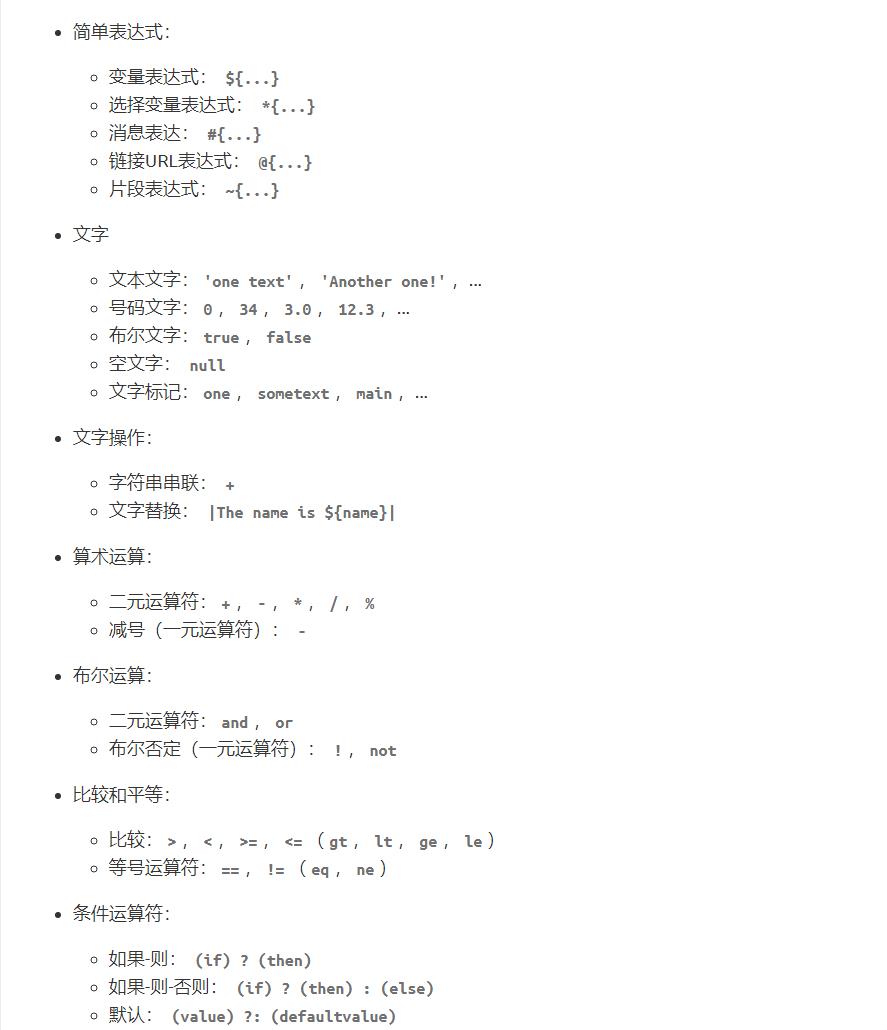Thymeleaf快速入门
Posted Pistachiout
tags:
篇首语:本文由小常识网(cha138.com)小编为大家整理,主要介绍了Thymeleaf快速入门相关的知识,希望对你有一定的参考价值。
1.什么是Thymeleaf
Thymeleaf是一个XML/Xhtml/HTML5模板引擎,可用于Web与非Web环境中的应用开发,它是一个开源的Java库。Thymeleaf提供了一个用于整合Spring MVC的可选模块,在应用开发中,你可以使用Thymeleaf来完全代替JSP或其他模板引擎,如Velocity、FreeMarker等。Thymeleaf的主要目标在于提供一种可被浏览器正确显示的、格式良好的模板创建方式,因此也可以用作静态建模。你可以使用它创建经过验证的XML与HTML模板,它的特点便是:开箱即用。
2.Springboot整合thymeleaf
实现的步骤为:
- 创建一个sprinboot项目
- 添加thymeleaf的起步依赖
- 添加spring web的起步依赖
- 编写html 使用thymleaf的语法获取变量对应后台传递的值
- 编写controller 设置变量的值到model中
pom.xml
<?xml version="1.0" encoding="UTF-8"?>
<project xmlns="http://maven.apache.org/POM/4.0.0"
xmlns:xsi="http://www.w3.org/2001/XMLSchema-instance"
xsi:schemaLocation="http://maven.apache.org/POM/4.0.0 http://maven.apache.org/xsd/maven-4.0.0.xsd">
<modelVersion>4.0.0</modelVersion>
<groupId>com.itheima</groupId>
<artifactId>springboot-thymeleaf</artifactId>
<version>1.0-SNAPSHOT</version>
<parent>
<groupId>org.springframework.boot</groupId>
<artifactId>spring-boot-starter-parent</artifactId>
<version>2.1.4.RELEASE</version>
</parent>
<dependencies>
<!--web起步依赖
Tomcat
Springmvc 引赖Jar包 一个中心 三大组件
-->
<dependency>
<groupId>org.springframework.boot</groupId>
<artifactId>spring-boot-starter-web</artifactId>
</dependency>
<!--thymeleaf配置-->
<dependency>
<groupId>org.springframework.boot</groupId>
<artifactId>spring-boot-starter-thymeleaf</artifactId>
</dependency>
</dependencies>
</project>
创建application.yml,并设置thymeleaf的缓存设置,设置为false。
spring:
thymeleaf:
cache: false
在resources中创建templates目录,在templates目录创建index.html,代码如下:
<!doctype html>
<html lang="ch" xmlns:th="http://www.thymeleaf.org">
<head>
<meta charset="UTF-8">
<title th:text="|lookroot-$title|">默认的标题</title>
<meta name="description" th:content="$description">
<meta name="keywords" th:content="$keywords">
</head>
</html>
<html xmlns:th="http://www.thymeleaf.org">这句声明使用thymeleaf标签
<title th:text="$title">默认的标题</title>这句使用 th:text="$变量名" 表示 使用thymeleaf获取文本数据,类似于EL表达式。
<title th:text="|lookroot-$title|">默认的标题</title>假如我们的 th:text 标签里面需要拼接字符串$title可以使用||来包裹
创建controller用于测试后台 设置数据到model中。
@Controller
public class IndexController
@GetMapping("/index")
public String index(Model model)
model.addAttribute("title", "传递的标题");
model.addAttribute("description", "传递的描述");
model.addAttribute("keywords", "传递的关键字");
return "index";
Thymeleaf常用语法

渲染对象
创建一个基本对象UserVO
@Data
public class UserVO
private String username;
private Integer age;
private Integer sex;
private Boolean isVip;
private Date createTime;
private List<String> tags;
新建一个方法basic,将user对象传输到页面中
@GetMapping("/basicTrain")
public String basic(Model model)
UserVO userVO = new UserVO();
userVO.setAge(21);
userVO.setSex(1);
userVO.setCreateTime(new Date());
userVO.setTags(Arrays.asList("Java", "php", "Node"));
userVO.setUsername("lookroot");
model.addAttribute("user", userVO);
return "basic";
新建basic.html,此时如果我们想渲染User这个对象的信息我们可以这样
<div>
<h2 th:text="$user.getUsername()"></h2>
<p th:text="$user.getAge()"></p>
</div>
也可以将User定义为临时变量,接着使用*xxx就能取到值了
<div th:object="$user">
<h2 th:text="*username"></h2>
<p th:text="*age"></p>
</div>
还可以不使用get的方式,直接使用属性名
<h2 th:text="$user.username" ></h2>
th:if使用
th:if通过布尔值决定这个元素是否渲染
<p th:if="$user.isVip">会员</p>
th:each使用
th:each可以迭代循环出数据,前面我们User对象里面的tags是一个数组,我们来渲染一下
<ul>
<li th:each="tag:$user.getTags()"
th:text="$tag"></li>
</ul>
状态变量在th:each属性中定义,并且包含以下数据:
当前的迭代索引,从0开始。这是index属性。.
从1开始的当前迭代索引。这是count属性。
迭代变量中元素的总数。这是size财产。
每次迭代的iter变量。这是current财产。
当前迭代是偶数还是奇数。这些是even/odd布尔属性。
当前迭代是否是第一个。这是first布尔属性。
当前迭代是否为最后一次。这是last布尔属性
th:switch使用
th:switch选择语句
<div th:switch="$user.getSex()">
<p th:case="'1'">男</p>
<p th:case="'2'">女</p>
<p th:case="*">默认</p>
</div>
url
如果在springboot中需要引入static目录下的静态资源可以使用@xxx的方式
<link th:href="@/app.css" rel="stylesheet">
javascript动态渲染
<script th:inline="javascript">
const user = /*[[$user]]*/ ;
console.log(user);
</script>
同理css也是可以的
<style th:inline="css">
.main\\ elems
text-align: /*[[$align]]*/ left;
</style>
Thymeleaf碎片(组件)
th:fragment
新建一个component.html,一个文件里面可以写多个碎片,使用th:fragment来定义
<footer th:fragment="com1">
this is com1
</footer>
<footer id="com2">
this is com2
</footer>
使用碎片主要有两种方式replace和insert,在index.html中编写
<!--replace-->
<div th:replace="~component::com1"></div>
<!--insert-->
<div th:insert="~component::com1"></div>
这两种方式的区别就是,replace会将新标签完全替换原本的标签,也就是说原本写th:replace属性的标签就不会渲染出来,insert是往这个地方插入标签
直接通过选择器使用
对于碎片,甚至可以不定义,我们再次添加一个 碎片
<footer id="com2">
this is com2
</footer>
然后使用它
<div th:insert="~component::#com2"></div>
注释类型
在碎片里面,我们是可以使用控制传递的数据的,比如上面的User对象,但是开发工具在component.html页面中可能不能识别到User对象,我们可以打一个注释
<!--/*@thymesVar id="user" type="cn.lookroot.loop.thymeleafdemo.vo.UserVO"*/-->
<div th:text="$user.getUsername()"></div>
组件传递参数
组件也是可以传递数据的
<div th:fragment="com3(message)">
<p th:text="$message"></p>
</div>
使用的时候
<div th:insert="~component::com3('传递数据')"></div>
局部替换组件
我们使用一个组件的时候,想要局部替换掉这个组件里面的部分内容该怎么做呢?通过传递参数的方式传递一个组件过来,并把这个组件替换原本的一部分
<div th:fragment="com4(message)">
<p th:replace="$message">原本的message</p>
</div>
使用的时候
<div th:insert="~component::com4(~::#message)">
<p id="message">替换的message</p>
</div>
基本对象
ctx:上下文对象
$#ctx.request
$#ctx.response
$#ctx.session
$#ctx.servletContext
请求/会话属性
$session.xxx
$application.xxx
$#request.getAttribute('xxx')
工具类
在thymeleaf里面是可以直接使用一些Java的函数的,并且你可以通过传递参数的方式把一些自己写的方法传递给页面,在里面调用也是可以的
#dates
#calendars
#strings
#numbers
#objects
#bools
#arrays
#lists
#sets
#maps
#aggregates
以日期格式化来举例
<!--日期格式化-->
<p th:text="$#dates.format(user.createTime,'yyyy-MM-dd HH:mm')"></p>
以上是关于Thymeleaf快速入门的主要内容,如果未能解决你的问题,请参考以下文章